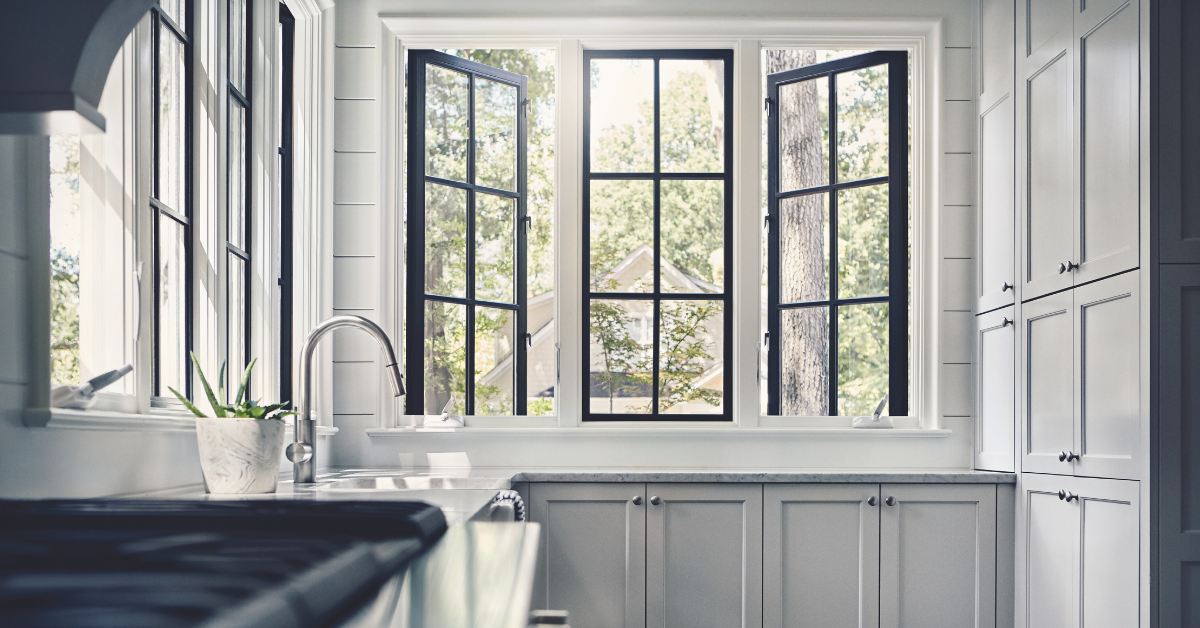Low-E glass is one of the standards used for energy efficiency as it is able to keep the indoor temperatures comfortable year-round no matter where you are located. Let’s break down what Low-E actually means, the different types, and what options are available through JELD-WEN Canada.
What is Low-E glass?
The “E” stands for emissivity which is the effectiveness of a surface to emit heat by radiation. Basically, it measures how much thermal energy, such as the sunlight or indoor heat, is absorbed or reflected away from the glass. Without a Low-E coating, plain clear glass has a high emissivity. The glass will absorb heat from the sun and transfer it directly into your home. When the emissivity is lowered it will reflect the heat from the sun rather back outside and keep the heat that’s already in the house inside which ultimately increases the glass’ insulation value.
All materials, including windows and glass doors, radiate heat in the form of long wave infrared energy, depending on the emissivity and temperature of the surface. Radiant energy is one of the most important ways heat transfer occurs within windows and glass doors. Reducing the emissivity of one or more of the surfaces improves the window’s performance and insulation properties. This is where Low-E glass coatings come into play.
Low-E or low-emissivity glass is created by applying a microscopically thin transparent coating of low-emittance metallic particles to the glass. This coating is able to reflect long wavelengths of infrared energy or heat and allow short wavelengths to pass through. With a Low-E coating you can get as much as 99 per cent reduction in ultraviolet light penetrating through your window. Not only will you get the benefits of energy efficiency, but this also means that your furniture, floor, carpet, etc. is not going to deteriorate or discolor as quick. Different Low-E glass types are achieved by changing the types of particles and increasing or decreasing the number of layers used on the glass. This allows for our windows to be designed to meet the needs of customers in any climate across the nation.
Low-E coatings can be applied to both the interior and exterior glass surfaces of a window or glass door in order to deliver the comfort and energy savings that best suits your climate. If you live in a warmer climate, the Low-E coating will be placed on the exterior pane of glass which will reflect the heat of the summer sun. If you live in a colder climate, the Low-E coating will be placed on the interior pane of glass which will reflect the existing heat inside to keep your home’s temperature levels comfortable. This how energy efficiency comes into play by keeping your home cooler in the summer and warmer in the winter.
While a Low-E coating is important, you should keep in mind that it is not the only factor involved in creating the most energy-efficient window or glass door. Double-pane glass is a lot more insulating than single-pane and tri-pane is the leading option. Insulation is also improved with the addition of argon or krypton gas in the sealed space between the panes of glass. Multiple glass panes allow for more surfaces to be coated with Low-E which will give you a customized approach. Additionally, all of the glass is typically held in place by thermally-efficient window frames or doors with insulating cores. Don’t worry about figuring this all out on your own. A JELD-WEN representative or official retailer can help you find the options that meet your specific needs.
SunStable™ Low-E insulating glass balances visible light and thermal performance. This option provides energy savings and improved home comfort year-round. The double-coated glass allows a little passive solar heat in the winter which reflects the heat back into the room and it blocks approximately 70 per cent of harmful UV rays. SunStable is a practical solution for homes in a wide range of climates.
SunResist™ Low-E insulating glass provides optimal thermal performance by helping homes stay cooler in the summer and warmer in the winter. This is a great choice for hotter and sunnier climates. SunResist features advanced, triple-coated glass that blocks more than 90 per cent of UV rays, a greater percentage than other Low-E glass options.
SunFlow™ Low-E insulating glass is expertly engineered to improve energy efficiency in colder climates, especially those with extreme winter temperatures. It offers the highest visible light transmission and maximizes the warmth available from the sun, allowing the sun to heat the home using a passive solar heat concept. It also blocks more than 55 per cent of harmful UV rays. The coldest Canadian winter is no match for SunFlow™ Low-E.
HeatSave™ interior Low-E coating reflects heat back into the home. It’s used in combination with other energy-efficient glasses to increase heat retention without sacrificing light transmittance. HeatSave™ helps maintain a more comfortable home in the coldest climates and at higher altitudes.
Related Articles








